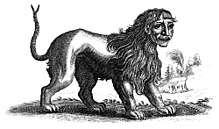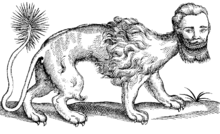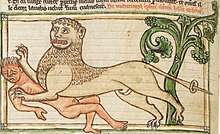Manticore
The manticore (Early Middle Persian: merthykhuwar; Persian: مردخوار mardykhor) is a Persian legendary creature similar to the Egyptian sphinx that proliferated in western European medieval art as well. It has the head of a human, the body of a lion and a tail of venomous spines similar to porcupine quills, while other depictions have it with the tail of a scorpion. There are some accounts that the spines can be shot like arrows, thus making the manticore a lethal predator. It devours its prey whole, using its triple rows of teeth, leaves no traces of its victims (including bones) behind.
 A manticore (1678) | |
| Grouping | Legendary creatures |
|---|---|
| Sub grouping | Mythological hybrids |
The mantyger is a creature of medieval invention, having the body of a heraldic tiger with mane, and the head of an old man, the tusks of a boar and with long spiral horns. Some heraldic authorities make the horns more like those of an ox, and the hands and feet like those of a monkey.
.jpg)

.jpg)
Name
Its name literally means "man-eater" (from early Middle Persian مارتیا mardya "man" (as in human) and خوار khowr- "to eat"). The English term "manticore" was borrowed from Latin mantichora, itself derived from the Greek rendering of the Persian name, μαρτιχόρα, martichora.
The Greeks called it androphagos (ἀνδροφάγος), which also means "man-eater".[1]
Origin
The manticore myth was of Persian origin. It passed into European folklore first through a remark by Ctesias, a Greek physician at the Persian court of King Artaxerxes II in the fourth century BC, in his book Indica ("India"), which circulated among Greek writers on natural history but has survived only in fragments, or references by those other writers.
Aelian, in his work Characteristics of Animals, had a complete section dedicated to manticore:
There is in India a wild beast, powerful, daring, as big as the largest lion, of a red colour like cinnabar, shaggy like a dog, and in the language of India it is called Martichoras. Its face however is not that of a wild beast but of a man, and it has three rows of teeth set in its upper jaw and three in the lower; these are exceedingly sharp and larger than the fangs of a hound. Its ears also resemble a man's, except that they are larger and shaggy; its eyes are blue-grey and they too are like a man's, but its feet and claws, you must know, are those of a lion. To the end of its tail is attached the sting of a scorpion, and this might be over a cubit in length; and the tail has stings at intervals on either side. But the tip of the tail gives a fatal sting to anyone who encounters it, and death is immediate. If one pursues the beast it lets fly its stings, like arrows, sideways, and it can shoot a great distance; and when it discharges its stings straight ahead it bends its tail back; if however it shoots in a backward direction, as the Sacae do, then it stretches its tail to its full extent. Any creature that the missile hits it kills; the elephant alone it does not kill. These stings which it shoots are a foot long and the thickness of a bulrush. Now Ctesias asserts (and he says that the Indians confirm his words) that in the places where those stings have been let fly others spring up, so that this evil produces a crop. And according to the same writer the Mantichore for choice devours human beings; indeed it will slaughter a great number; and it lies in wait not for a single man but would set upon two or even three men, and alone overcomes even that number. All other animals it defeats: the lion alone it can never bring down. That this creature takes special delight in gorging human flesh its very name testifies, for in the Greek language it means man-eater, and its name is derived from its activities. Like the stag it is extremely swift. Now the Indians hunt the young of these animals while they are still without stings in their tails, which they then crush with a stone to prevent them from growing stings. The sound of their voice is as near as possible that of a trumpet. Ctesias declares that he has actually seen this animal in Persia (it had been brought from India as a present to the Persian King) — if Ctesias is to be regarded as a sufficient authority on such matters. At any rate after hearing of the peculiarities of this animal, one must pay heed to the historian of Cnidos.[2][3]
The Romanised Greek Pausanias, in his Description of Greece, recalled strange animals he had seen at Rome and commented:
The beast described by Ctesias in his Indian history, which he says is called martichoras by the Indians and "man-eater" [androphagos] by the Greeks, I am inclined to think is the tiger. But that it has three rows of teeth along each jaw and spikes at the tip of its tail with which it defends itself at close quarters, while it hurls them like an archer's arrows at more distant enemies; all this is, I think, a false story that the Indians pass on from one to another owing to their excessive dread of the beast.[1]
Pliny the Elder did not share Pausanias' skepticism. He followed Aristotle's natural history by including the martichoras – mistranscribed as manticorus in his copy of Aristotle – among his descriptions of animals in Naturalis Historia 8:30, c. 77 AD.
Later, in The Life of Apollonius of Tyana, Greek writer Flavius Philostratus (c. 170–247) wrote:
And inasmuch as the following conversation also has been recorded by Damis as having been held upon this occasion with regard to the mythological animals and fountains and men met with in India, I must not leave it out, for there is much to be gained by neither believing nor yet disbelieving everything. Accordingly Apollonius asked the question, whether there was there an animal called the man-eater (martichoras); and Iarchas replied: "And what have you heard about the make of this animal? For it is probable that there is some account given of its shape." "There are," replied Apollonius, "tall stories current which I cannot believe; for they say that the creature has four feet, and that his head resembles that of a man, but that in size it is comparable to a lion; while the tail of this animal puts out hairs a cubit long and sharp as thorns, which it shoots like arrows at those who hunt it."[4]
Medieval and post-medieval appearances



Pliny's book was widely enjoyed through the European Middle Ages, during which the manticore was sometimes described or illustrated in bestiaries. Through false etymology, it was sometimes assumed that the name was an amalgamation of man and tiger.[5] However, other sources regarded the mantyger as a different creature entirely. The mantyger was often depicted as having monkey-like feet, being apparently inspired by the baboon, and sometimes being represented with either tusks or short horns.[6] There was further confusion as to whether the manticore should be identified with or distinguished from the satyral and the lampago.[7]
Dante Alighieri, in his Inferno, depicted the mythical Geryon as a manticore, following Pliny's description.[8]
The manticore (mantyger) first appeared in English heraldry in c. 1470, as a badge of William Hastings, 1st Baron Hastings; and in the 16th century, it was used as a badge by Robert Radcliffe, 1st Earl of Sussex, and by Sir Anthony Babyngton.[9]
Edward Topsell, in 1607, described the manticore as:
bred among the Indians, having a treble rowe of teeth beneath and above, whose greatnesse, roughnesse, and feete are like a Lyons, his face and eares like unto a mans, his eies grey, and collour red, his taile like the taile of a Scorpion of the earth, armed with a sting, casting forth sharp pointed quills, his voice like the voice of a small trumpet or pipe, being in course as swift as a Hart; His wildnes such as can never be tamed, and his appetite is especially to the flesh of man. His body like the body of a Lyon, being very apt both to leape and to run, so as no distance or space doth hinder him, and I take it to bee the same Beast which Avicen calleth Marion, and Maricomorion, with her taile she woundeth her Hunters whether they come before her or behind her, and presently when the quils are cast forth, new ones grow up in their roome, wherewithal she overcommeth all the hunters: and although India be full of divers ravening beastes, yet none of them are stiled with a title of Andropophagi, that is to say, Men-eaters; except onely this Mantichora. When the Indians take a Whelp of this beast, they all to bruise the buttockes and taile thereof, that so it may never be fit to bring sharp quils, afterwards it is tamed without peril.[10]
Randle Holme drew on this description in 1688, when he described the manticore (which he regarded as distinct from the mantyger) as having:
the face of a man, the mouth open to the ears with a treble row of teeth beneath and above; long neck, whose greatness, roughness, body and feet are like a Lyon: of a red colour, his tail like the tail of a Scorpion of the Earth, the end armed with a sting, casting forth sharp pointed quills.[11]
The heraldic manticore influenced some Mannerist representations of the sin of Fraud, conceived as a monstrous chimera with a beautiful woman's face – for example, in Bronzino's allegory Venus, Cupid, Folly and Time (National Gallery, London),[12] and more commonly in the decorative schemes called grotteschi (grotesque). From here it passed by way of Cesare Ripa's Iconologia into the seventeenth- and eighteenth-century French conception of a sphinx.
Gerald Brenan linked the manticore to the mantequero, a monster feeding on human fat in Andalusian folklore.[13]
In some modern depictions, such as in the tabletop role-playing game Dungeons & Dragons and the card game Magic: The Gathering, manticores are depicted as having wings.[14]
See also
- Keibu Keioiba, a tiger-headed man
References
- Pausanias, Description of Greece, 9.21.4
- Aelian, Characteristics of Animals, 4.21 - GR
- Aelian, Characteristics of Animals, 4.21
- Flavius Philostratus, The Life of Apollonius of Tyana, translated by F. C. Conybeare, volume I, book III. Chapter XLV, pp. 327–329.
- "manticore". Oxford English Dictionary (3rd ed.). Oxford University Press. September 2005. (Subscription or UK public library membership required.)
- Dennys (1975), pp. 114–7
- Dennys (1975), p. 114
- Dante Alighieri; Grandgent, C. H (1933). La Divina commedia di Dante Alighieri (in Italian). Boston; New York: D.C. Heath and Co. OCLC 1026178.
Dante's image was profoundly modified, however, by Pliny's description---followed by Solinus---of a strange beast called Mantichora (Historia Naturalis, VIII, 30) which has the face of a man, the body of a lion, and a tail ending in a sting like a scorpion's
- Dennys (1975), pp. 115–6
- Topsell, Edward (1607). The Historie of Foure-footed Beasts. London. p. 442.
- Holme, Randle (1688). The Academy of Armorie and Blazon. Chester. p. 212.; quoted in Dennys 1975, p. 115.
- Moffitt, John F. (1996). "An Exemplary Humanist Hybrid: Vasari's "Fraude" with Reference to Bronzino's "Sphinx"". Renaissance Quarterly. 49 (2): 303–333. doi:10.2307/2863160. JSTOR 2863160. traces the chimeric image of Fraud backwards from Bronzino.
- Al Sur de Granada, pages 190-193, Gerald Brenan, 1997, Fábula - Tusquets Editores. Originally South from Granada, 1957
- Wood, Juliette (2018). Fantastic Creatures in Mythology and Folklore: From Medieval Times to the Present Day. Bloomsbury Publishing. p. 44. ISBN 978-1-3500-5925-2.
Further reading
- Dennys, Rodney (1975). The Heraldic Imagination. London: Barrie & Jenkins.CS1 maint: ref=harv (link)